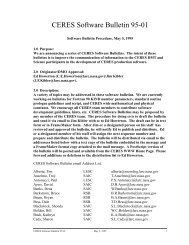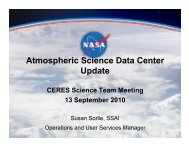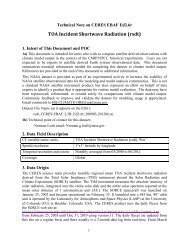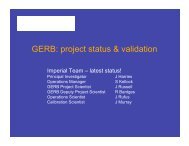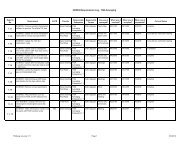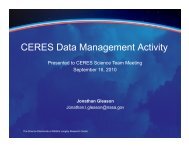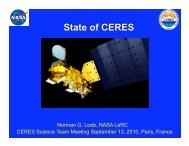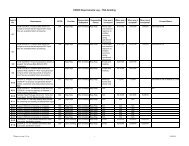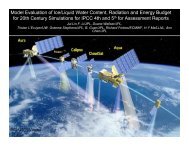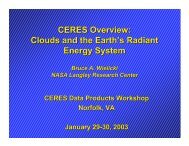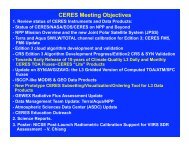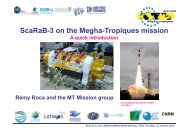CERES FM1-FM6 Instrument Status Report - NASA
CERES FM1-FM6 Instrument Status Report - NASA
CERES FM1-FM6 Instrument Status Report - NASA
You also want an ePaper? Increase the reach of your titles
YUMPU automatically turns print PDFs into web optimized ePapers that Google loves.
<strong>CERES</strong> <strong>Instrument</strong> and Calibration <strong>Status</strong><br />
Kory Priestley<br />
~ The entire <strong>Instrument</strong> Working Group Team ~<br />
Presented by:<br />
Kory Priestley<br />
Marriott at City Center<br />
Newport News, VA<br />
April 26, 2011
Outline!<br />
<strong>CERES</strong> <strong>FM1</strong>-<strong>FM6</strong> <strong>Instrument</strong> <strong>Status</strong> <strong>Report</strong> (Priestley)<br />
-! EOS Flight Hardware Performance & <strong>Status</strong><br />
-! EOS Data Product <strong>Status</strong><br />
-! Climate Data Record Continuity Path Forward<br />
-! FM5 on NPP<br />
-! <strong>FM6</strong> on JPSS - 1<br />
-! ERBS on JPSS -2<br />
<strong>NASA</strong> Langley Research Center / Science Directorate!
<strong>Instrument</strong> Working Group Personnel<br />
Science<br />
- Susan Thomas -<br />
Audra Bullock<br />
Janet Daniels<br />
Phil Hess<br />
Suzanne Maddock<br />
Mohan Shankar<br />
Nathaniel Smith<br />
Nitchie Smith<br />
Peter Szewczyk<br />
Robert Wilson<br />
Data Management<br />
- Denise Cooper -<br />
- Dale Walikainen -<br />
Thomas Grepiotis<br />
Nelson Hillyer<br />
Jeremie Lande<br />
Dianne Snyder<br />
Richared Spivak<br />
Mark Timcoe<br />
S/C Integration & Test<br />
- Roy Zalameda -<br />
James Adams<br />
Mike Tafazoli<br />
Eugene Sutton<br />
Bruce Wolff<br />
Mission Operations<br />
- Bill Vogler -<br />
- James Bailey -<br />
Christopher Brown<br />
~ Jim Donaldson ~<br />
John Butler<br />
William Edmonds<br />
Kelly Teague<br />
Significant increases have been necessary to implement new FM5 and <strong>FM6</strong> work<br />
<strong>NASA</strong> Langley Research Center / Science Directorate!
<strong>Instrument</strong> Working Group Roles & Responsibities<br />
<strong>NASA</strong> Langley Research Center / Science Directorate!
<strong>Instrument</strong> and ERBE-Like Processing Stream<br />
<strong>NASA</strong> Langley Research Center / Science Directorate!
Radiometric Performance Requirements<br />
<strong>CERES</strong> is defined as a class ‘B’ Mission<br />
5-year design Lifetime!<br />
Spectral<br />
Regions<br />
Solar<br />
Terrestrial<br />
Atmospheric<br />
Window<br />
Wavelengths 0.3 - 5.0 µm 5.0 - 200 µm 8 - 12 µm<br />
Scene levels 100 w/m 2 -sr 100 w/m 2 -sr All Levels<br />
Accuracy<br />
Requirements<br />
SOW Stability<br />
Requirements<br />
0.8 w/m 2 -sr 1.0 % 0.8 w/m 2 -sr 0.5 % 0.3 w/m 2 -sr<br />
< 0.14%/yr < 0.1%/yr<br />
Climate<br />
Stability Goals<br />
< 0.6 w/m 2 /dec<br />
< 0.03 %/yr<br />
< 0.2 w/m 2 /dec<br />
< 0.02%/yr<br />
•! Requirements for <strong>CERES</strong> are more stringent than ERBE’s by a factor of 2<br />
•! Requirements per Ohring et. al. are more stringent than <strong>CERES</strong> by a factor of 3-5<br />
Calibrate, Calibrate, Calibrate….<br />
<strong>NASA</strong> Langley Research Center / Science Directorate!
Why is <strong>CERES</strong> Climate Quality Calibration so difficult?!<br />
A question of time scales, experience and balancing accuracy with providing<br />
data products to the community.<br />
- Calibrated Radiances have been released on ~6 month centers<br />
- 6 months is just a blink of an eye when analyzing long term trends…<br />
Same time scale as phenomena which influence instrument response<br />
- Beta Angle<br />
- Earth Sun Distance<br />
- Orbital shifts/maintenance/maneuvers<br />
- <strong>Instrument</strong> Operational modes (I.e RAPS vs. Xtrack)<br />
Design weaknesses and failures in onboard calibration hardware<br />
- full spectral range of observations not covered by cal subsystems (PFM-<strong>FM6</strong>)<br />
Complicates separation of instrument ‘artifacts’ from natural variability.<br />
Edition3 reprocessing of the first 10 years of radiances allows a more rigorous<br />
identification and separation of instrument artifacts and climate signals.<br />
<strong>NASA</strong> Langley Research Center / Science Directorate!
Enabling Climate Data Record Continuity<br />
<strong>CERES</strong> Flight Schedule<br />
Spacecraft <strong>Instrument</strong>s Launch<br />
Science<br />
Initiation<br />
Collected Data<br />
(Months)<br />
TRMM PFM 11/97 1/98 9<br />
Terra <strong>FM1</strong>, FM2 12/99 3/00 133 +<br />
Aqua FM3, FM4 5/02 6/02 106 +<br />
NPP FM5 9/11 - -<br />
JPSS - 1 <strong>FM6</strong> 2016 (TBR) - -<br />
JPSS - 2 ERBS 2020 (TBR) - -<br />
40 + <strong>Instrument</strong> Years of Data!<br />
<strong>NASA</strong> Langley Research Center / Science Directorate!
Enabling Climate Data Record Continuity<br />
<strong>CERES</strong> Flight Schedule<br />
Sensors:<br />
Missions with ERB Observations<br />
PFM FM-1,2 FM-3,4<br />
FM-5 FM-6 ERBS<br />
TRMM (11/97)<br />
Terra (12/99)<br />
Aqua (5/02)<br />
Initial Studies/Reqmts Development<br />
Sensor Fab, Assembly, Test<br />
Spacecraft I&T<br />
Launch Readiness Window<br />
Nominal Mission Lifetime<br />
Operational Lifetime<br />
NPP (10/11)<br />
FM-5<br />
JPSS-1 (11/16)<br />
FM-6<br />
JPSS-2 (11/19)<br />
<strong>CERES</strong> Follow-on +<br />
CY:<br />
97 98 99 00 01 02 03 04 05 06 07 08 09 10 11 12 13 14 15 16 17 18 19 20 21<br />
<strong>NASA</strong> Langley Research Center / Science Directorate!
Enabling Climate Data Record Continuity<br />
Agency Roles and Responsibilities<br />
Mission<br />
<strong>Instrument</strong>s<br />
Responsible Agency<br />
($$ in budget)<br />
Hardware<br />
Science, Data<br />
Processing<br />
Implementation<br />
Hardware<br />
Science, Data<br />
Processing<br />
EOS PFM-FM4 <strong>NASA</strong> <strong>NASA</strong><br />
NPP FM5 <strong>NASA</strong>/NOAA <strong>NASA</strong><br />
JPSS-1 <strong>FM6</strong> NOAA NOAA<br />
<strong>NASA</strong><br />
Procurement<br />
<strong>NASA</strong><br />
Procurement<br />
<strong>NASA</strong><br />
Procurement<br />
<strong>NASA</strong><br />
Science Team<br />
<strong>NASA</strong><br />
Science Team<br />
TBR<br />
JPSS-2<br />
<strong>CERES</strong><br />
follow-on<br />
NOAA<br />
NOAA<br />
<strong>NASA</strong><br />
Procurement<br />
TBR<br />
<strong>NASA</strong> Langley Research Center / Science Directorate!
EOS <strong>Status</strong><br />
<strong>NASA</strong> Langley Research Center / Science Directorate!
<strong>CERES</strong>/EOS Operational History<br />
With the exception of the SW channel on the <strong>CERES</strong>/Aqua FM-4 <strong>Instrument</strong>,<br />
the <strong>CERES</strong> Terra/Aqua instruments are functioning nominally…<br />
Spacecraft <strong>Instrument</strong>s Launch<br />
Science<br />
Initiation<br />
Collected Data<br />
(Months)<br />
TRMM PFM 11/97 1/98 9<br />
Terra <strong>FM1</strong>, FM2 12/99 3/00 133 +<br />
Aqua FM3, FM4 5/02 6/02 106 +<br />
NPP FM5 10/11 - -<br />
JPSS - 1 <strong>FM6</strong> 2018 - -<br />
JPSS - 2 ERBS - -<br />
40 + <strong>Instrument</strong> Years of Data!<br />
<strong>NASA</strong> Langley Research Center / Science Directorate!
Terra/Aqua <strong>Instrument</strong> and ERBE-Like Availability!<br />
Spacecraft Product Version Available Months Processed<br />
TRMM BDS Edition1 Yes 1/98 - 8/98 , 3/00<br />
ERBE-Like Edition1 Yes 1/98 - 8/98 , 3/00<br />
Edition2 Yes 1/98 - 8/98 , 3/00<br />
Terra BDS Edition1CV Yes 2/00 - present<br />
Edition2 Yes 2/00 – 6/10<br />
Editon3 Yes 2/00 – 11/10<br />
ERBE-like Edition1CV Yes 3/00 - present<br />
Edition2 Yes 2/00 – 6/10<br />
Editon3 ASDC Testing 3/00 – 11/10<br />
Aqua BDS Edition1CV Yes 6/02 - present<br />
Edition2 Yes 6/02 – 6/10<br />
Editon3 Yes 2/00 – 11/10<br />
ERBE-like Edition1CV Yes 7/02 - present<br />
Edition2 Yes 7/02 – 6/10<br />
Editon3 ASDC Testing 7/02 – 11/10<br />
Note: Red cells indicate datasets that are no longer in production.!<br />
<strong>NASA</strong> Langley Research Center / Science Directorate!
Cal/Val Protocol Overviews!<br />
Edition1_CV - Static Algorithms and coefficients - baseline product used in<br />
cal/val protocol<br />
Edition2 - Utilizes temporally varying coefficients to correct for traceable<br />
radiometric drift. All spectral changes are broadband and ‘gray’.<br />
(EOS Ed2 Production ended with 6/2010)<br />
Edition3 - Accounts for temporally varying spectral artifacts in the SW and<br />
LW measurements.<br />
User Applied Revisions - Advance capabilities to the users prior to the<br />
release of the next Edition.<br />
Edition3 products lag Edition1 by a minimum of 6-12 months<br />
<strong>NASA</strong> Langley Research Center / Science Directorate!
<strong>CERES</strong> Calibration Input Parameters<br />
Coefficients updated in Cal/Val Protocols<br />
Traceability Matrix<br />
Category Parameter Edition1 Edition2 Edition3<br />
Radiometry Gain Static Piecewise linear ~ 6<br />
month intervals<br />
Continuous, based<br />
upon ICS<br />
Spectral Response Static Gray Changes Wavelength<br />
Dependent Changes<br />
Scan Dependent Offsets Ground Ground Terra - DSCAL<br />
Aqua -TBD<br />
2 nd Time Constant Ground Ground Flight<br />
Thermal Correction Common Correction Common Correction <strong>Instrument</strong> Specific<br />
IBB PRT Coefficients Static Static Static<br />
Pointing Alignment Static Static Static<br />
Gimbal Offsets Static Static Static<br />
Time Response Static Static Static<br />
<strong>NASA</strong> Langley Research Center / Science Directorate!
FM-5 on NPP<br />
<strong>Status</strong><br />
<strong>NASA</strong> Langley Research Center / Science Directorate!
<strong>CERES</strong> Flight Project Organization<br />
<strong>NASA</strong> Langley Research Center / Science Directorate!
<strong>CERES</strong> Compatibility with NPP Spacecraft<br />
.108m<br />
ST1<br />
ST2<br />
3.720m<br />
4.026m<br />
.141m<br />
BCL<br />
RADIATOR<br />
VIIRS<br />
RADIATOR<br />
RF ACCESS<br />
DOOR<br />
SSW1<br />
ATMS<br />
RADIATOR<br />
VIIRS OM<br />
75°<br />
VIIRS EM<br />
ATMS<br />
PROPULSION MODULE<br />
SSW2<br />
+X<br />
(Velocity)<br />
OMPS<br />
+Z<br />
(Nadir)<br />
<strong>CERES</strong><br />
Observatory Information<br />
!! Launch Readiness October, 2011<br />
!! Location - Vandenberg AFB<br />
!! Launch Vehicle - Delta II<br />
!! Altitude - 824 Km<br />
-! <strong>CERES</strong> FOV increases to ~ 24Km<br />
!! Inclination - Sun-Synch, 98.7-deg<br />
!! Crossing Time - 1:30pm, Ascending<br />
!! Payload -<br />
-! <strong>CERES</strong><br />
-! VIIRS<br />
-! OMPS<br />
-! CRIS<br />
-! ATMS<br />
<strong>NASA</strong> Langley Research Center / Science Directorate!
<strong>CERES</strong> FM5 Hardware <strong>Status</strong> & Near-Term Activities<br />
•!<br />
Fabrication, Assembly and Test Program is complete<br />
–! Ground Calibration was most extensive to date in the <strong>CERES</strong> Program<br />
•! System Acceptance Review 10/30 at NGST<br />
•! Shipped to BATC on 11/2/09<br />
•! Mechanical/Electrical Integration to NPP spacecraft completed 11/11/08<br />
•! Observatory Pre-environmental Test Readiness Review 9/20-21/10<br />
•! Spacecraft Environmental Campaign 11/10-4/11<br />
•! Operational Readiness Review 6/20-24/11<br />
•! Satellite Pre-Ship Review 8/2/11<br />
•! Mission Readiness Review (L-75) 9/6/11<br />
•! Flight Readiness Review (L-4) 10/21/11<br />
•! Launch Readiness Review (L-1) 10/24/11<br />
•! NPP ‘Official’ Launch Readiness Date is currently October 25, 2011<br />
–! Initial NPP launch date was mid-2006<br />
<strong>NASA</strong> Langley Research Center / Science Directorate!
Observatory TVAC Testing Complete<br />
<strong>NASA</strong> Langley Research Center / Science Directorate!
<strong>CERES</strong> FM-5 on NPP TVAC Timeline<br />
48 consecutive days of testing<br />
Door Close : 3/10/2011 : Door Open : 3/27/2011<br />
Contam Doors<br />
Opened/closed<br />
<strong>NASA</strong> Langley Research Center / Science Directorate!
FM-5 TVAC Internal Cal Results<br />
<strong>CERES</strong> is the only instrument with no outstanding<br />
instrument or science related TAWSs.<br />
<strong>NASA</strong> Langley Research Center / Science Directorate!
NPP Path to Launch – Ground System Prep<br />
•!<br />
•!<br />
•!<br />
•!<br />
Update NPP RDR Preprocessor software to fix issues discovered<br />
during NCT 3 Part II. "<br />
–! Delivery to <strong>CERES</strong> CM May 6 (L-5 months)."<br />
Update NPP <strong>Instrument</strong> Main Processor software to fix issues<br />
discovered during TVAC and NCT 3 Part II. "<br />
–! Delivery to <strong>CERES</strong> CM May 13 (L-5 months)."<br />
Provide updated instrument parameters, gains, spectral response<br />
functions, etc. (Scan dependent offsets set to zero, Second Time<br />
Constant correction turned off) "<br />
–! Delivery to <strong>CERES</strong> CM July 25 (L-3 months). "<br />
Flight Verification of NPP RDR Preprocessor/<strong>Instrument</strong> Main<br />
Processor during NCT 4 (7/5-18/11). "<br />
–! Delivery any final updates <strong>CERES</strong> CM 2 weeks after NCT 4 (L-3 months)."<br />
<strong>NASA</strong> Langley Research Center / Science Directorate!
Post-Launch Data Product Strategy<br />
•!<br />
•!<br />
•!<br />
First 6 months after launch (Edition1_CV)<br />
–! Analyze in-flight data to determine any changes to <strong>Instrument</strong><br />
parameters, gains, spectral response functions, scan dependent<br />
offsets, etc."<br />
1 year after launch (Edition2)"<br />
–! Delivery to <strong>CERES</strong> CM, ground based scan dependent offsets,<br />
turn-on second time constant calculations with values determined<br />
after launch, update gains if necessary with in-flight values (if large<br />
changes seen in-flight vs ground)."<br />
2 to 3 years after launch (Edition3)"<br />
–! Determine if any gain and spectral response function trends have<br />
occurred during the mission. Delivery to <strong>CERES</strong> CM updated gains<br />
(including ground to flight shifts) and spectral response functions,<br />
deep space cal determined scan dependent offsets, etc."<br />
<strong>NASA</strong> Langley Research Center / Science Directorate!
Aqua/Terra and NPP Intercomparison Opportunities<br />
•!<br />
Primary comparison - Aqua and NPP:<br />
–! Ascending 1330 orbits, inclination angles differ by about 0.5°<br />
•! Simultaneous (within 6.6s)<br />
»! Groundtrack difference for lat < 0.25 deg; lon < 2 deg<br />
»! Each opportunity lasting 1 minute<br />
•! Matched sites (within 0.25deg)<br />
»! Time differential < 5 min.<br />
»! Groundtrack difference for lat < 0.25 deg.; lon < 0.25 deg<br />
»! Varying duration of each opportunity from 1 to 5 minutes<br />
•!<br />
Secondary comparison - Terra and NPP:<br />
–! Descending 0930 and Ascending 1330 orbits<br />
•! Matched sites (within 0.25deg)<br />
»! Time differential < 5 min.<br />
»! Groundtrack difference for lat < 1.0 deg.; lon < 1.0 deg<br />
»! Duration of each opportunity ~20 seconds<br />
<strong>NASA</strong> Langley Research Center / Science Directorate!
Aqua and NPP : Simultaneous Matches<br />
11 day-night opportunities within 27 days; about 64 hours apart<br />
<strong>NASA</strong> Langley Research Center / Science Directorate!
Aqua and NPP : Matched Sites<br />
8 day-night opportunities within 27 days<br />
<strong>NASA</strong> Langley Research Center / Science Directorate!
Terra and NPP : Matched Sites<br />
2 night opportunities within 27 days<br />
<strong>NASA</strong> Langley Research Center / Science Directorate!
Summary<br />
NPP Mission Video<br />
<strong>NASA</strong> Langley Research Center / Science Directorate!
FM-6 on JPSS-1<br />
<strong>Status</strong><br />
<strong>NASA</strong> Langley Research Center / Science Directorate!
<strong>CERES</strong> <strong>FM6</strong> <strong>Status</strong> & Near-Term Activities<br />
•! Project received ~$5M for <strong>FM6</strong> in CY08<br />
•! Allowed for enhanced study phase only, start 11/08<br />
•! Long Lead item procurements authorized 3/09<br />
•! Contract negotiations completed 4/23/09<br />
•! Key Milestone Dates (Preliminary)<br />
–! Authority To Proceed – 5/1/09<br />
–! Systems Readiness Review – 9/22/09<br />
–! Delta Preliminary Design Review – January 2010<br />
–! Delta Critical Design Review – September 28, 2010<br />
–! All major subassemblies delivered to NG, currently in sensor I&T<br />
–! Ground Calibration Campaign – Spring 2012<br />
–! Delivery – Summer/Fall 2012<br />
–! Launch Readiness Date of Jan, 2015 (TBR)<br />
–! Launch Date of Oct. 2016 (TBR)<br />
<strong>NASA</strong> Langley Research Center / Science Directorate!
Summary<br />
NPP Mission Video<br />
<strong>NASA</strong> Langley Research Center / Science Directorate!
BACK-UP SLIDES<br />
<strong>NASA</strong> Langley Research Center / Science Directorate!
<strong>NASA</strong> Langley Research Center / Science Directorate!
ASIC 3 (2006) Workshop Recommendations<br />
- Partially redundant on-board calibrations to improve knowledge of instrument stability.<br />
Improvements are needed in broadband MAM or diffuser designs to meet the new climate<br />
stability requirements.<br />
- More careful attention be paid to potential contamination of optical surfaces for climate<br />
instruments during ground testing, as well as improving the technologies for measuring and<br />
correcting any potential contamination.<br />
- Flight of the <strong>CERES</strong> FM-5 instrument use only the crosstrack scan mode to avoid in-orbit<br />
contamination of the SW channel optics. We also recommend that future calibration<br />
observatories in space be designed to explicitly account for expected in-orbit<br />
contamination, even if its level is small.<br />
- Future broadband instruments should examine the potential for 0.3 to 0.5 µm sources<br />
such as small nonlinear optics lasers to explicitly monitor throughput below 0.5 µm. This issue<br />
appears to exist for all instruments measuring solar radiation with wavelengths below 0.5 µm<br />
and should be accounted for in calibration system design.<br />
<strong>NASA</strong> Langley Research Center / Science Directorate!



